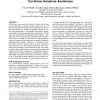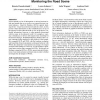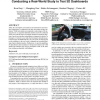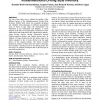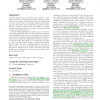124
click to vote
AUTOMOTIVEUI
2015
ACM
9 years 3 months ago
2015
ACM
Inattentiveness is one of the major causes of traffic accidents. Advanced car safety systems try to mitigate this by detecting potential signs of distraction or tiredness, and pr...
AUTOMOTIVEUI
2015
ACM
9 years 3 months ago
2015
ACM
This paper examines the response of 10 typical and 10 autism spectrum participants in their reaction to a set of uniand multisensory warning signals designed to indicate different...
AUTOMOTIVEUI
2015
ACM
9 years 3 months ago
2015
ACM
Self-driving vehicles are able to drive on their own as long as the requirements of their autonomous systems are met. If the system reaches the boundary of its capabilities, the s...
AUTOMOTIVEUI
2015
ACM
9 years 3 months ago
2015
ACM
Drivers attend to a lot of information at various locations inside and outside the car as well as on external devices (e.g. smart phones). Head-Up Displays (HUDs) support keeping ...
AUTOMOTIVEUI
2015
ACM
9 years 3 months ago
2015
ACM
Driving is a safety critical task that requires a high level of attention and workload from the driver. Despite this, people often also perform secondary tasks such as eating or u...
AUTOMOTIVEUI
2015
ACM
9 years 3 months ago
2015
ACM
Today, the vast majority of research on novel automotive user interface technologies is conducted in the lab, often using driving simulation. While such studies are important in e...
AUTOMOTIVEUI
2015
ACM
9 years 3 months ago
2015
ACM
The aim of this study was to validate the stability of the different factors of the Multidimensional Driving Style Inventory (MDSI) [16], which was originally developed and valida...
AUTOMOTIVEUI
2015
ACM
9 years 3 months ago
2015
ACM
This paper presents a first evaluation of multimodal language-based warnings for handovers of control in autonomous cars. A set of possible handover situations varying in urgency ...
OZCHI
2015
ACM
9 years 3 months ago
2015
ACM
Different graph layouts can affect a user’s ability to complete both passive understanding and active interaction tasks. While most research exploring the effects of graph la...
OZCHI
2015
ACM
9 years 3 months ago
2015
ACM


